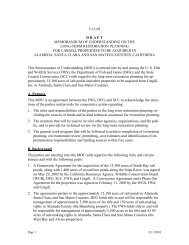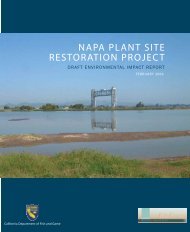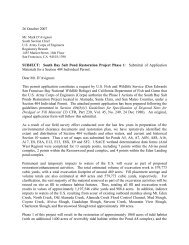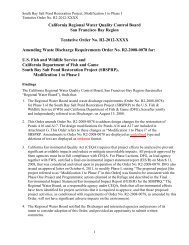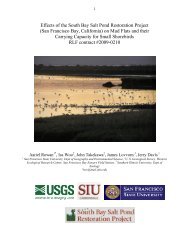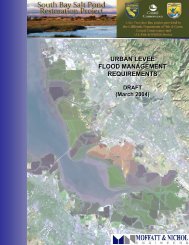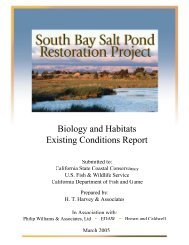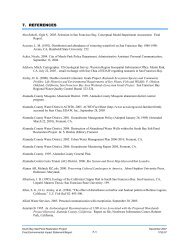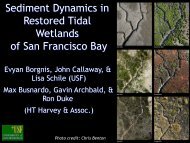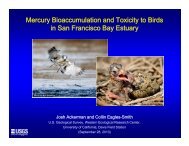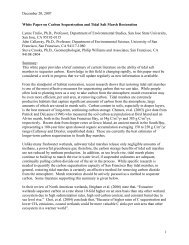M E M O R A N D U M - South Bay Salt Pond Restoration Project
M E M O R A N D U M - South Bay Salt Pond Restoration Project
M E M O R A N D U M - South Bay Salt Pond Restoration Project
You also want an ePaper? Increase the reach of your titles
YUMPU automatically turns print PDFs into web optimized ePapers that Google loves.
Creek Reach 1A pond) with certain characteristics by high numbers of birds. The ability of reconfigured<br />
ponds to attract and support high densities of migrant and breeding waterbirds has been well established<br />
based on 10 years of experimentation and management experience in the San Joaquin Valley, where the<br />
suite of species using these managed ponds is very similar to those currently using <strong>South</strong> <strong>Bay</strong> salt ponds<br />
(Gordus and others 1996; H.T. Harvey & Associates 1996). Given that such intensively reconfigured<br />
ponds have not yet been constructed in the immediate <strong>South</strong> <strong>Bay</strong> area, the use of reconfigured ponds by<br />
the SBSP <strong>Restoration</strong> <strong>Project</strong> is considered experimental. These ponds will not be implemented at a<br />
broad scale until construction and maintenance costs of the pilot reconfigured ponds are determined, the<br />
benefits of increased bird use have been determined by monitoring, and these costs and benefits can be<br />
adequately compared.<br />
4.1.1.5 Vegetated <strong>Pond</strong>s<br />
There are certain circumstances where it may be desirable to manage vegetated ponds, rather than allow<br />
such areas to be fully tidal. For example, managed, diked salt marsh, such as now exists in New Chicago<br />
Marsh in Alviso, may be created in some ponds by managing water levels and allowing (or promoting)<br />
vegetation establishment in order to provide protected reserves for the salt marsh harvest mouse while<br />
providing nesting, foraging, brooding, and roosting habitat for shorebirds and waterfowl as well.<br />
Vegetated ponds will require water management, either through controlled, muted tidal action, or via<br />
water control structures (gravity flow or pumping). They may require some initial grading, and/or<br />
internal water control structures, depending on the management goal. Full tidal action may eventually be<br />
restored to vegetated ponds to create tidal marsh, depending on the management goal and pond<br />
characteristics (e.g., degree of subsidence).<br />
4.1.2 Tidal Habitat<br />
Tidal habitat is a general term that refers to the range of habitats between subtidal bay and uplands. These<br />
primarily consist of unvegetated mudflats, emergent marsh, tidal channels, tidal ponds, salt pans, salt<br />
marsh, and upland transition zones. Each of these tidal habitats has unique functions and values that<br />
contribute to the health of the estuary. For example, salt marsh and upland transition zones are critical<br />
for the salt marsh harvest mouse, while emergent marshes comprised of pickleweed and cordgrass with<br />
complex dendritic tidal channel networks are important for the California Clapper Rail. Meanwhile,<br />
shorebirds, waterfowl, and other waterbirds will utilize the unvegetated mudflats, salt pans, tidal channels<br />
and associated tidal ponds. This mosaic of habitat types with a range of values for numerous species is<br />
referred to collectively as tidal habitat.<br />
Breaching and/or removing artificial outboard levees will restore the twice-a-day ebb and flow of the<br />
tides through the ponds. The bay waters bring with them sediments from the <strong>Bay</strong>, which will be<br />
deposited in the ponds. The sedimentation process can be accelerated in certain areas by preserving<br />
sections of levees as wave breaks to create sheltered areas. Emergent marsh vegetation will colonize in<br />
the higher elevation tidal areas. Some areas of the ponds are at elevations where vegetation such as<br />
cordgrass and pickleweed will colonize rapidly. Other areas will require the build up of mudflats through<br />
<strong>South</strong> <strong>Bay</strong> <strong>Salt</strong> <strong>Pond</strong> <strong>Restoration</strong> <strong>Project</strong> January 2005<br />
Preliminary <strong>Project</strong> Alternatives Memorandum 9 1750.01





